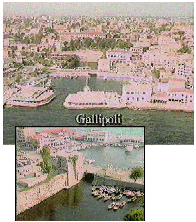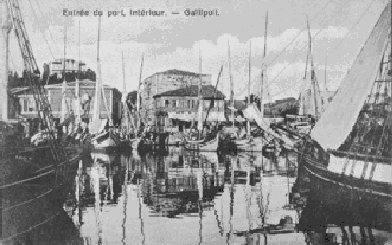The Sephardic Community of Gallipoli (Gelibolu)
(Kahal Kadosh Gallipoli)
Page 2.
Port City
Gallipoli, the city, lies on the peninsula of the same name. Gallipoli comes from the Greek word Kallipolis, meaning "beautiful city". In Turkish, Gallipoli is known as Gelibolu. The peninsula was the site of a famous World War I battle in which the Turkish victory prevented Turkey's dismemberment by European powers. Gallipoli is a port city (Figures 4 and 5). It was a major port for the Ottoman Navy.
 |
 |
|
Figure 4. Gallipoli is a beautiful
city. Two video frames from a Turkish VCR tape (reference unavailable)
on the life Ottoman cartographer Piri Reis show aerial views of Gallipoli's
harbor reflecting when the city's role as headquarters for the Ottoman
Navy.
|
|
Figure 6. The main street running through the Jewish section of Gallipoli was "Kara-Kaldirim", located "an easy walk from the pier", and had an incline. The above shows the 19th century home of one Sephardic family (i.e., Sheby) that was still standing in 1978 on "Kara-Kaldirim" (Source: D. Sheby).
Population
Gallipoli's Jewish population was small. In the late 19th century Gallipoli was one of six sanjaks in the vilayet Edirne whose population between 1881 and 1914 is shown in Table 1. Prior to 1864 Gelibolu was a large sanjak in the vilayet of Rumili. In 1864 Gelibolu became a sanjak of Edirne vilayet, which was affected by the Congress of Berlin (1878) when large areas of Ottoman Europe (in the Balkans) were lost. In 1870 Gelibolu sanjak had 6 kazas later reduced to the 3 kazas in Table 1.
|
Table 1: Population of Edirne vilayet (and its sanjaks) in the late 19th century. (Note: this table does not use correct punctuation of Turkish geographic names. Adapted from (a) Peker, Ugar A.: Osmanli Imparatoriugu Idari Taksimat ve Posta S,ubeleri Hircri 1306, Miladi 1890 (The Administrative Division and the Post Offices in the Ottoman Empire), Bermen Philatelics, 1984; (b) Karpat, Kemal H: Ottoman Population 1830-1914, University of Wisconsin Press, 1985, ISBN 0-299-09160-0. and (c) Weiker, Walter F: Ottomans, Turkis, and the Jewish Polity: A History of the Jews of Turkey, University Press of America, Lantham, MD., 1992, ISBN 0-8191-8644-9 (pp. 135-138) (in turn based on Karpat)) |
||||
|
Sanjaks in the vilayet
Edirne in 1890.
|
Kazas in the sanjak |
Jewish population 1881-2/1893 |
Jewish population 1906-07 |
Jewish population 1914 |
|
Dedegac [Dedeagatch] (now known as Alexandropoulis) |
-
|
35 |
326 |
annexed to Bulgaria; now part of Greece. |
|
Edirne (Andrinople) |
Edirne, Mustafa Pasha, Seymenli, Dimetoka, Uzunkopru |
8,918 |
15,534 |
15,685 |
|
Gallipoli (Gelibolu) |
Gallipoli, Kesan, Eceabad |
1,604 |
2,336 |
2,580 |
|
Gumulcene (Komotini) |
-
|
604 |
1,290 |
part of Greece |
|
Kirkilise |
Kirkaleri, Luleburgaz, Babaeski |
900 |
1,699 |
1,469 |
|
Tekfurdagi (Rodosto) |
Tekirdag, Corlu, Saray |
1,656 |
2,654 |
2,781 |
Figure 7. The vilayet (provice) of Edirne and its six (6) sanjaks (counties) in 1890. Prior to 1864, Gallipoli was a sanjak within the vilayet of Rumili (comprising Bulgaria) and had 6 kazas of its own. In 1864 the sanjak of Gallipoli was assigned to the vilayet of Edirne, and in 1870 its kazas were reduced in number to the three (3) listed in Table 1 and shown above. The extent of the Sanjak of Gallipoli (pre-1864) is shown in the insert (yellow color, from Karpat). (Note: For the relationship among vilayet, sanjak, and kaza, click here.) Map image from the collection of Shelomo Alfassa; Osmanlica translation by M. Pixley.Families from Gallipoli
1) Some family names from Gallipoli in the early 20th century include: Aboulafia, Abravenel, Condiotti, Habib, Mezistrano, Sheby, Varon, and Yohai. (Note: the name "Habib" has two additional forms, i.e., "Abn-Habib" and "Ibn-Habib".
2) Professsor Minna Rozen photographed 835 tombstones in Gallipoli's cemetary [6].
3) A memorial [7] to Ottoman Sephardim who emigrated to the United States at the beginning of the twentieth century includes photographs of three (3) families from Gallipoli:
a) David Habib, with wife Signure and family in Gallipoli: emigrated approximately 1910.
b) Nissim Levy, with wife Bolissa and family in Gallipoli, emigrated approximately 1910
c) Albert Abravenel in New York City 1914, emigrated approximately 1911.6.
Communal Functions and Structure
1) The Alliance Israélite Universelle established a school for boys and girls in Gallipoli in 1905, in which 219 students were enrolled. [8]
2) Gallipol's Jewish community was led by a council (Figure 7) composed of seven prominent men ([1], p. 49) known as the "zayin tovi ha-eyr" ("the seven good of the city"), whose decisions were binding.
3) Professor Bunis lists "Shevat Tzion" ("Return of Zion") as "an organization in Gelibolu" [9]
Figure 8. (left) A 1923 photo from a Salonika almanac shows "Los Notablis Judios di la Komonitah di Gallipoli" (but 9 are pictured!). [Note: the above Ladino text is the associated caption from the original photo. Image (and proper name transcription) courtesy of Dov Cohen, Deputy Director, Library, Ben-Zvi Institute, Israel, http://sites.huji.ac.il/ybz/eng/e01-ybz.htm ]. Pictured in Figure 8. are: a) first row: Gabriel Yohai, Gabbai of the kehilah; Shimon Abulafia, President of the Bikor Holim; Morenu Condiotti, Member of the Communal Council b) second row: Hasday Ibn-Shador, Vice-President of the Council; Marko Varon, President; Jak Mizistrano, Cashier c) third row: Asher Ibn-Habib, Member; Izak Habib, Member; Behor Hahamoglu, Member
Miscellaneous
1) . Ships regularly visited Gallipoli [1, 10]. In the 19th century, private shipping companies were authorized to carry Ottoman and foreign mail, and stopped in Gallipoli. The Austrian Shipping Company arrived in Gallipoli every Tuesday, and the port was a regular stopover for the Roston Shipping Company which arrived from Marseille [10]
2) Gallipoli's most famous citizen was the Ottoman cartographer Piri Reis, whose maps are reknown for their accuracy and knowledge of world geography. The city's most infamous "guest" was the "false Messiah" Shabbetai Sevi who was imprisoned there in 1666.
References
[1] Gal, Danit: The Jewish Community of Gallipoli (1453-1700), Masters Thesis, Tel Aviv University, Faculty of the Humanities, Department of Jewish History, November, 1997. (In Hebrew; four page English summary) (Prepared under the supervision of Professor Minna Rozen).
[2] Angel, Marc D.: La America: The Sephardic Experience in the United States, Jewish Publication Society, 1982
[3] Gursan-Salzmann, Ayse and Laurence Salzmann: Anyos Munchos I Buenos : Turkey's Sephardim : 1492-1992, 1991.Philadelphia : Blue Flower/Photo Review Book
[4] Weinstein, Jay: A Collector's Guide to Judaica, Thames and Hudson, 1985.
[5] Yeshiva University Museum, The Sephardic Journey: 1492-1992, New York, 1992, ISBN 0-945447-04-3)
[6] Rozen, Minna: "A Survey of Jewish Cemeteries in Western Turkey", The Jewish Quarterly Review, vol. 83, Nos. 1-2 (July-October, 1992), pp. 71-125.
[7] A Journey Through Time, The Sephardic Home, Brooklyn, NY, 1993, LCC# 93-084358
[8] Dumont, Paul "Jewish Communities in Turkey during the Last Decades of the Nineteenth Century in the Light of the Archives of the Alliance Israélite Universelle", Chapter 11 (pp. 209-242) in Braude, B., and B. Lewis (Eds): Christians and Jews in the Ottoman Empire: Volume I The Central Lands, ISBN 0-8419-0519-3, Holmes & Meier Publishers, Inc. New York, 1982
[9] Bunis, David: A Lexicon of the Hebrew and Aramaic Elements in Modern Judezmo, Magnes Press, The Hebrew University, and Misgav Yerushalayim, Jerusalem, 1993.
[10] From: OPAL (Oriental Philatelic Association of London) Journal, volume 185, "Shipping Companies Carrying Ottoman and Foreign Post", pp. 29-30 (translated by Jeff Ertughrul from "Turkiye Posta Telgraf ve Telefon Tarihi ve Teshkilat ve Mevzuati" by Asaf Tanrikut, volume 1).
a) p. 29 "Austrian Shipping Company .. every Tuesdays (sic) sailing to Gelibolu …"
b) p. 30 "Roston Shipping Company ... arrived from Marseille on Fridays calling at Ligorne, Malta, Izmir, Midili, Gelibolu. This journey took 15 days."
Return to Page 1.